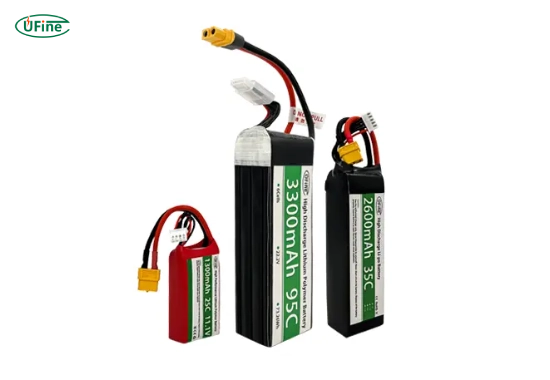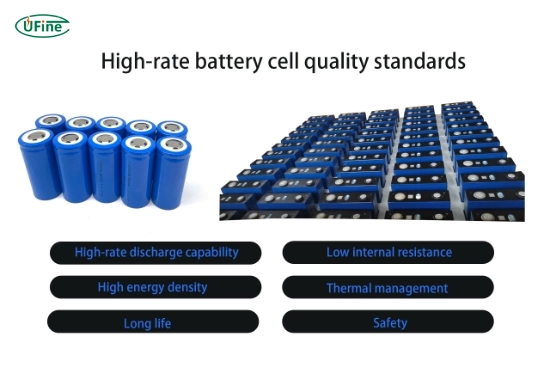The high-rate discharge battery is an indispensable power source in today’s rapidly advancing technological landscape. This comprehensive guide delves into the intricacies of high-rate discharge batteries, exploring their characteristics, types, applications, and distinguishing features compared to conventional battery solutions.
Part 1. What is a high-rate discharge battery?
A high-rate discharge or high-power battery is precisely engineered to rapidly deliver enormous amounts of power without compromising performance or longevity.
Manufacturers identify these batteries with labels that indicate high discharge capabilities, highlight specifications with high C-rate values, ensure compatibility with devices requiring bursts of power, and design them with physical characteristics like larger electrodes or thicker cell walls.
These features make high-rate discharge batteries essential for applications demanding quick and reliable power delivery, such as electric vehicles, power tools, and drones.
Part 2. High-rate discharge battery characteristics
Enhanced Discharge Efficiency
With optimized electrode materials and electrolyte composition, high-rate discharge batteries boast high discharge efficiency, converting stored energy into usable power with minimal loss, ideal for maximizing energy utilization.
High Output Power and Energy Density
These batteries, engineered for rapid power delivery, offer high output power capabilities, providing instantaneous bursts of energy for applications requiring quick response times. Additionally, they possess high energy density, packing significant energy into a compact form factor, essential for space-constrained environments.
Low Internal Resistance
These batteries are designed with low internal resistance, enabling them to transfer energy efficiently without significant loss. This characteristic ensures the battery can sustain high discharge rates without overheating or voltage drops.
Fast Charge and Discharge Rates
High-rate discharge batteries excel in rapid charge and discharge cycles. They can absorb and release energy quickly, making them ideal for applications requiring immediate bursts of power, such as electric vehicles and power tools.
Enhanced Thermal Management
High-rise discharge batteries often incorporate advanced thermal management systems to handle the increased energy transfer during rapid discharge. These systems help dissipate heat generated during high-power operations, ensuring the battery remains within safe operating temperatures.
Long Cycle Life
Despite their high discharge capabilities, these batteries maintain a long cycle life. Through careful engineering and material selection, manufacturers optimize the battery’s durability, allowing it to withstand numerous charge and discharge cycles without significant degradation in performance.
Part 3. Types of high-rate discharge batteries
Lithium-ion Batteries
Lithium-ion batteries are among the most common types of high-rate discharge batteries. They offer high energy density and efficiently handle rapid charge and discharge cycles. Portable electronics, electric vehicles, and renewable energy storage systems widely use these batteries.
Lithium Polymer Batteries
Lithium polymer batteries, or LiPo batteries, are a variant of lithium-ion batteries with flexible, pouch-like packaging. They provide high discharge rates and excellent energy density, making them popular for RC vehicles, drones, and high-performance gadgets.
Nickel-metal Hydride (NiMH) Batteries
NiMH batteries offer a balance between cost, performance, and environmental impact. While not as energy-dense as lithium-based batteries, they can still deliver high discharge rates suitable for power tools, hybrid vehicles, and specific consumer electronics.
Nickel-cadmium (NiCd) Batteries
Despite declining popularity due to environmental concerns, NiCd batteries still find applications in devices requiring high discharge rates and robustness. Emergency lighting, professional power tools, and aviation applications commonly use them.
Lead-acid Batteries
Although less efficient or compact than other types, lead-acid batteries can provide high discharge rates and robust performance in demanding industrial applications. Backup power systems, forklifts, and uninterruptible power supplies (UPS) often use them.
Graphene-based Batteries
Emerging technologies like graphene-based batteries show promise in delivering high-rate discharge capabilities along with improved energy density and cycle life. These batteries are still in the experimental stage but hold the potential for revolutionizing energy storage in the future.
Part 4. High discharge battery applications
Electric Vehicles (EVs)
High-discharge batteries are the power source for electric cars, motorcycles, and scooters. They provide quick acceleration and can handle the high power demands of electric motors.
Drones and Remote-Controlled (RC) Vehicles
These batteries offer the high power needed for drones and RC vehicles to perform rapid movements, such as takeoffs, quick turns, and acrobatics.
Portable Power Tools
Cordless drills, saws, and other power tools rely on high-discharge batteries for their portability and power, enabling them to operate efficiently without being plugged in.
Emergency Power Systems (UPS)
In uninterruptible power supplies, these batteries deliver immediate power during outages, protecting computers, medical equipment, and other critical devices from data loss or damage.
Renewable Energy Storage
High-discharge batteries store energy from solar panels or wind turbines, providing power when sunlight or wind is insufficient. They can quickly release energy to meet sudden demand spikes.
Medical Devices
Portable medical devices, such as defibrillators and portable oxygen concentrators, depend on high-discharge batteries for their reliability and the ability to deliver power instantly when needed.
Smartphones and Laptops
Modern smartphones and laptops require batteries that can support fast charging and deliver power efficiently to support high-performance processors and bright screens.
Military and Aerospace
In demanding environments, high-discharge batteries power equipment requiring reliability and high power output, including satellites, jet fighters, and uncrewed aerial vehicles (UAVs).
Part 5. What is the difference between a high-rate discharge battery and a standard battery?
Discharge Rate
Manufacturers design high-rate discharge batteries to release energy much faster than standard batteries. This capability means high-rate discharge batteries can quickly provide a large amount of power, making them perfect for devices needing quick bursts of energy.
Energy Density
While high-rate discharge batteries often have high power output, standard batteries may have higher energy density, meaning they can store more energy but release it more slowly.
Durability
Manufacturers build high-rate discharge batteries to withstand the stress of rapid charging and discharging without significant degradation. Standard batteries may wear out faster under such conditions.
Cost
Due to their advanced materials and technology, high-rate discharge batteries typically cost more than standard batteries, which are for slower discharge rates and longer, steadier use.
Applications
Users employ high-rate discharge batteries in applications requiring instant power, such as drones, electric vehicles, and power tools. Standard batteries are suited for everyday electronics, such as remote controls, flashlights, and clocks.
Chemistry
Manufacturers often tailor the chemical composition of high-rate discharge batteries to support quick energy release. Standard batteries use more straightforward chemistry focused on energy storage and longevity.
Size and Weight
High-rate discharge batteries may be larger or heavier than standard batteries of the same capacity due to the need for robust materials and construction to handle the high power demands.
Part 6. FAQs
-
What is high battery discharge?
High battery discharge means a battery gives out much power very quickly. -
What is a safe battery discharge rate?
A safe battery discharge rate is how fast you can use the battery’s power without causing harm. It’s different for each type of battery. -
What is the discharge rate of a 100Ah battery?
The discharge rate of a 100Ah battery tells you how many amps you can use in one hour. For example, if it’s rated for 1C, you can safely use 100 amps in one hour. -
What does the discharge rate mean?
Discharge rate is how quickly a battery loses its power. It’s usually shown as a C-rate, like 1C or 2C, which tells how many times the battery capacity can be used in one hour. -
What is the high rate discharge of a lead acid battery?
High rate discharge of a lead acid battery refers to using its power very quickly. It could be more efficient and can shorten the battery life. Lead acid batteries are better at high-speed discharge than some other types, like lithium batteries.
Related Tags:
More Articles

LiPo Battery Discharge Rate Guide & Calculation Tips
Understand LiPo battery discharge rates, C-ratings, and how to calculate max current. Essential guide for RC, drones, and electronics users.
High‑Capacity 3S LiPo Batteries: 5000 mAh vs. 10000 mAh
Compare 3S LiPo 5000mAh vs 10000mAh batteries by weight, power, and use. Find the best fit for your drone, RC car, or boat setup.
Top 5 Applications for Small 3S LiPo Batteries
Small 3S LiPo batteries power drones, RC gear, wearables, and robotics with high energy and low weight. Making them ideal for compact electronics projects.
Building and Charging Your Own 3S LiPo Pack: A Step‑by‑Step Guide
Learn how to build, balance, and charge a 3S LiPo battery pack safely at home with this complete DIY guide for hobbyists and beginners.
How to Choose the Right LiPo Battery Plug Type?
Discover the best LiPo battery plug types, how to choose them, and expert tips for safe usage, soldering, and maintenance.





